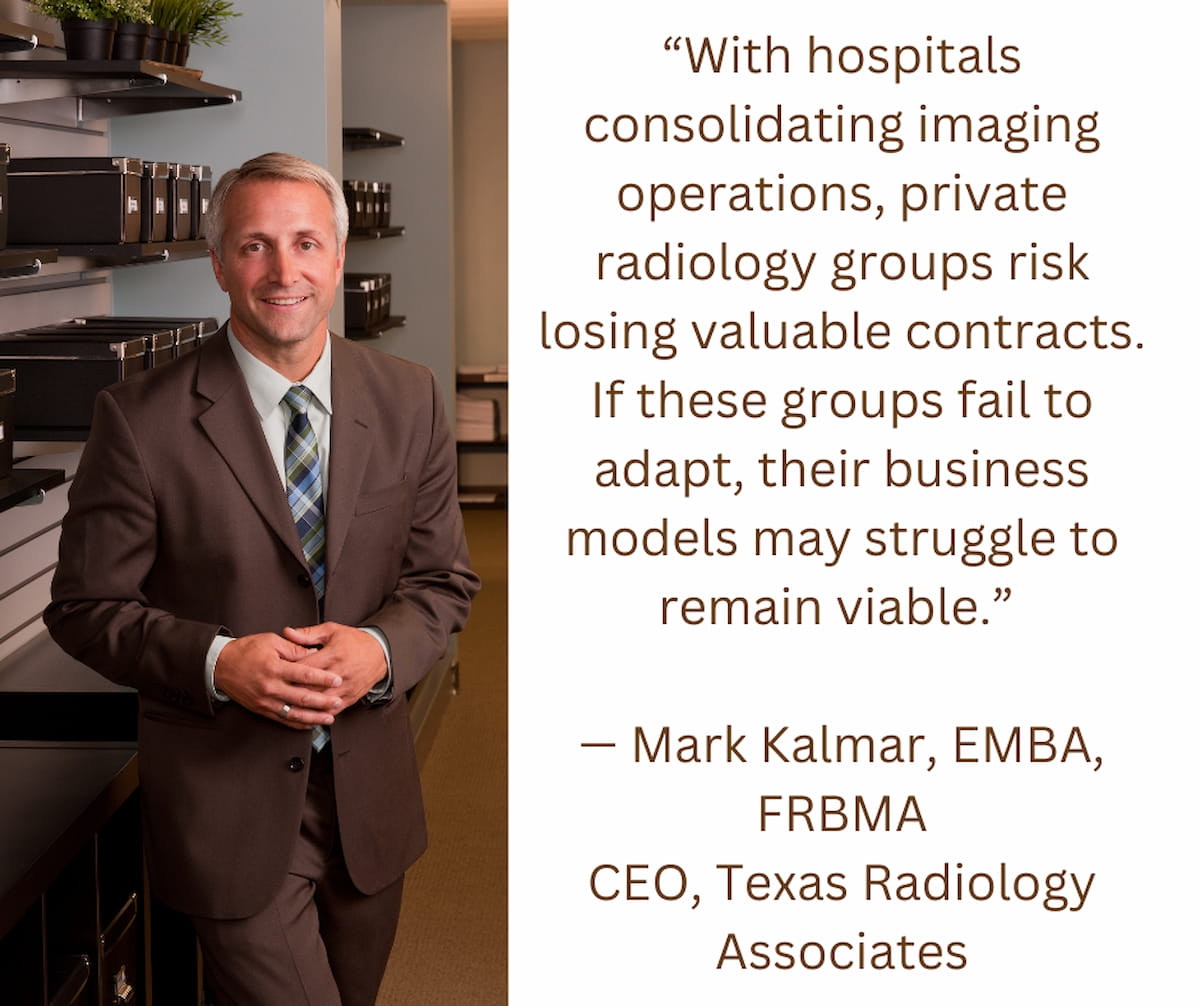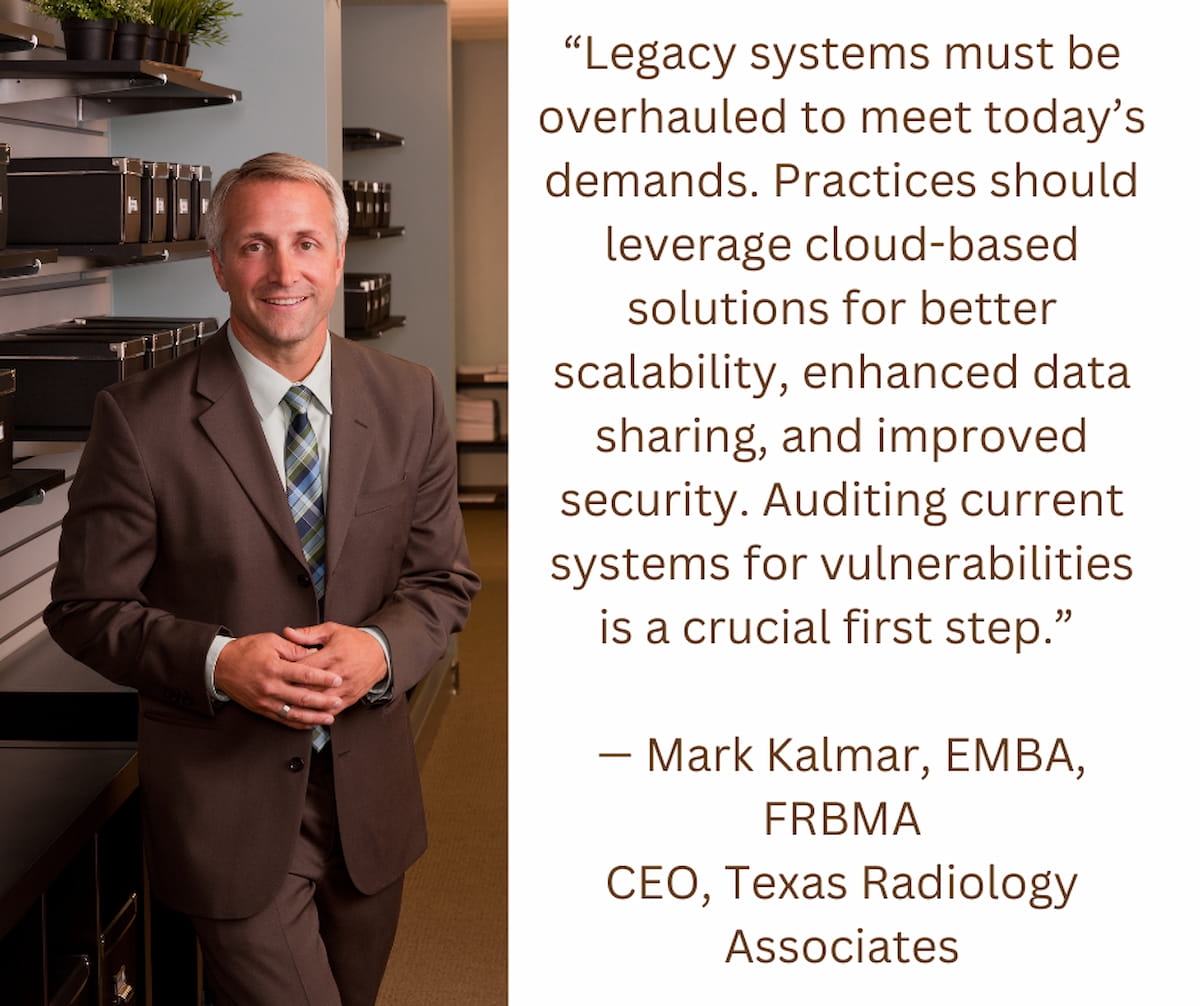Shaping the Future of Radiology in 2025: Trends, Threats, and Opportunities
How do we respond to challenges with staff recruitment, cybersecurity, and looming hospital takeovers in radiology? This author assesses key trends in radiology and offers key insights to stay competitive in the field.
Radiology is undergoing significant changes in 2025 that are driven by health-care advances, regulatory challenges, and workforce dynamics. Key trends include hospital consolidation of radiology services, the need for stronger cybersecurity, and innovative strategies to address staffing shortages. Adjusting to these shifts will be crucial for radiology professionals and organizations to remain competitive. Radiology professionals and groups must prepare now to adapt and thrive in this complex landscape.
Where Things Stand with the Hospital Takeover in Radiology
The health-care landscape is witnessing a notable shift as hospitals evaluate taking radiology services in-house. With radiologists facing their fifth consecutive pay cut due to the 2025 Medicare Physician Fee Schedule, radiology practices are approaching hospital partners for stipends to continue offering their advanced services. Once reliant on partnerships with private radiology groups, hospitals are weighing these stipend requests against hiring their own radiologists and physician extenders to perform low-risk, low-complexity procedures. This transition is fueled by the growing demand for imaging services, efforts to reduce operational costs, and the need to ensure consistent service quality.
There are a number of potential impacts with this ongoing transition.
More pressure on private practices. With hospitals consolidating imaging operations, private radiology groups risk losing valuable contracts. If these groups fail to adapt, their business models may struggle to remain viable.
Technology investments: Hospitals are ramping up investments in advanced imaging technology, using innovation as a competitive differentiator to attract patients.

A new career landscape for radiologists: Working in a hospital setting may provide radiologists with more predictable career structures, but it could also result in increased administrative burdens and a loss of workplace autonomy.
Private radiology practices must clearly articulate their value proposition to their hospital partners and build a strong understanding of the competitive landscape in radiology. Offering specialized niche services or emphasizing patient-centered care where hospitals fall short could help them carve out a new role in the evolving health-care ecosystem.
Understanding The Cybersecurity Imperative in Radiology Practices
Data breaches are no longer hypothetical risks. They are an ongoing reality, especially in health-care environments. While hospitals often benefit from larger IT infrastructures, independent radiology practices can be particularly vulnerable. The numbers are staggering. Reportedly 77.78% of health-care cyber incidents in 2024 were caused by hacking, ransomware, or phishing attempts.1
Beyond violating patient trust and regulatory compliance, compromised data disrupts clinical workflows and can negatively impact patient care. With extensive amounts of patient data associated with high-volume imaging services, radiology practices are becoming prime targets for cybercriminals. Advanced radiology practices already recognize this threat and are taking immediate, robust action.
Key Strategies for Mitigating Cybersecurity Risks
• Employee training. Ensuring staff stays up to date on the latest cybersecurity trends is essential. Comprehensive training programs empower employees to recognize phishing attempts and adopt secure practices. This is particularly important for departments like help desk support, which may prioritize customer satisfaction over security.
• Modernizing IT infrastructure. Legacy systems must be overhauled to meet today’s demands. Practices should leverage cloud-based solutions for better scalability, enhanced data sharing, and improved security. Auditing current systems for vulnerabilities is a crucial first step.
• Continuous monitoring and zero-trust protocols. Real-time monitoring and zero-trust security architectures significantly reduce the risk of breaches. The traditional “trust but verify” approach must evolve into “verify everything.”

Data security breaches are more than just IT issues. They have a direct impact on patient care. Health-care practices that prioritize preparedness not only build trust but also strengthen their resilience in an increasingly digital landscape.
Addressing the Recruitment Challenge and Evaluating Emerging Employment Models
The shortage of radiologists and technologists has taken center stage. With demand rising sharply due to an aging population, traditional staffing models are struggling to meet the needs of both radiologists and the groups that depend on their expertise. Tackling this growing issue has become an urgent priority.
• Teleradiology and remote work. The rise of teleradiology is reshaping the field. Flexible remote work options help radiologists achieve work-life balance and attract younger professionals who value flexibility over rigid schedules.
• Addressing burnout. Chronic burnout has pushed radiologists to seek roles with reduced on-call responsibilities and better balance between patient care and personal time. Employers must address this issue or risk losing talent to startups or alternative career paths.
• Rural recruitment challenges. Remote and underserved areas are under significant strain, often struggling to fill vacancies for over a year. Increasing salaries in these regions alone may not be enough to close the hiring gap.
Innovative Solutions to Bridge Workforce Gaps
• Flexible hybrid work models. Combining remote teleradiology opportunities with in-person responsibilities can broaden the talent pool and improve job satisfaction.
• Employee wellness initiatives. Prioritizing wellness programs can help combat burnout, including offering mental health resources, flexible schedules, and manageable workloads.
• Investing in retention. Consider educational sponsorships for certifications and providing paid study leave. Non-monetary rewards, such as conference attendance and recognition, may also provide value to staff. Clear career pathways within organizations, including leadership opportunities. Use advanced AI tools to streamline workflows and reduce stress on radiology teams.
Radiology in 2025: A Time for Innovation
What will these challenges mean for healthcare administrators and radiology professionals? It’s clear that adaptability will define success in 2025. Practices that invest in the latest technology, foster workplace innovation, and prioritize patient care will emerge as leaders in the field.
Even with workplace changes and recruitment incentives, systemic reform will be essential. Policymakers must champion initiatives such as frameworks to manage imaging demand appropriately and prevent radiologists from being overburdened. The radiology community must also collectively educate policymakers and advocate for alternative delivery and payment models, emphasizing the minimized downstream healthcare costs enabled by early diagnoses.
Radiology remains a dynamic and vital health-care sector, but its future hinges on how stakeholders—hospitals, private practices, policymakers, and innovators—respond to today’s pressing challenges. Those who seize these opportunities and act boldly will not only shape the future of imaging but also ensure radiology continues to deliver life-saving results for patients.
Are you ready to shape the future of radiology in 2025?
Mr. Kalmar is the CEO of Texas Radiology Associates, one of the nation’s largest radiology groups, and an award-winning health-care executive with over two decades of experience. He specializes in strategic planning, operational management, revenue cycle optimization, diagnostic imaging, systems integration, and team leadership.
Reference
1. Adler S. H1, 2024 healthcare data breach report. HIPAA Journal. Available at: https://www.hipaajournal.com/h1-2024-healthcare-data-breach-report/#:~:text=H1%2C%202024%20Hacking%2FIT%20Incidents,the%20January%20to%20June%20total. Published July 30, 2024. Accessed January 10, 2025.
The Reading Room Podcast: Emerging Trends in the Radiology Workforce
February 11th 2022Richard Duszak, MD, and Mina Makary, MD, discuss a number of issues, ranging from demographic trends and NPRPs to physician burnout and medical student recruitment, that figure to impact the radiology workforce now and in the near future.
New Collaboration Offers Promise of Automating Prior Authorizations in Radiology with AI
March 26th 2025In addition to a variety of tools to promote radiology workflow efficiencies, the integration of the Gravity AI tools into the PowerServer RIS platform may reduce time-consuming prior authorizations to minutes for completion.
Strategies to Reduce Disparities in Interventional Radiology Care
March 19th 2025In order to help address the geographic, racial, and socioeconomic barriers that limit patient access to interventional radiology (IR) care, these authors recommend a variety of measures ranging from increased patient and physician awareness of IR to mobile IR clinics and improved understanding of social determinants of health.